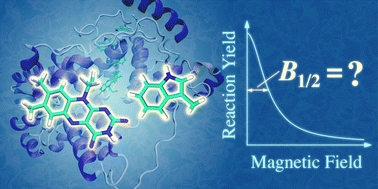Magnetic field effects on radical pair reactions: estimation of B1/2 for flavin-tryptophan radical pairs in cryptochromes†
Abstract
Magnetic field effects on the yields of radical pair reactions are often characterised by the “half-field” parameter, B1/2, which encodes useful information on spin relaxation, radical recombination kinetics and electron-electron couplings as well as electron–nuclear hyperfine interactions. Here we use a variety of spin dynamics simulation methods to estimate the hyperfine-only values of B1/2 for the flavin-tryptophan radical pair, [FAD˙− TrpH˙+], thought to be the detector in the magnetic compass sense of migratory songbirds. The main findings are: (a) in the absence of fast recombination and spin relaxation, [FAD˙− TrpH˙+] radical pairs in solution and in the putative magnetoreceptor protein, cryptochrome, have B1/2 ≈ 1.89 mT and 2.46 mT, respectively. (b) The widely used expression for B1/2 due to Weller et al. (Chem. Phys. Lett, 1983, 96, 24–27) is only applicable to small, short-lived (∼5 ns), rapidly tumbling radical pairs in solution, and is quantitatively unreliable in the context of magnetoreception. (c) In the absence of molecular tumbling, the low-field effect for [FAD˙− TrpH˙+] is predicted to be abolished by the anisotropic components of the hyperfine interactions. Armed with the 2.46 mT “base value” for cryptochrome, measurements of B1/2 can be used to understand the impact of spin relaxation on its performance as a magnetic compass sensor.

- This article is part of the themed collection: 2022 PCCP HOT Articles


 Please wait while we load your content...
Please wait while we load your content...